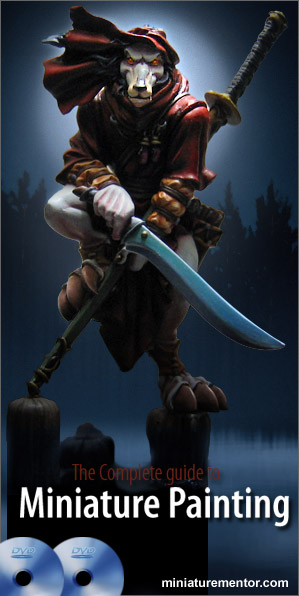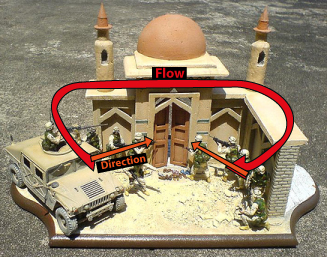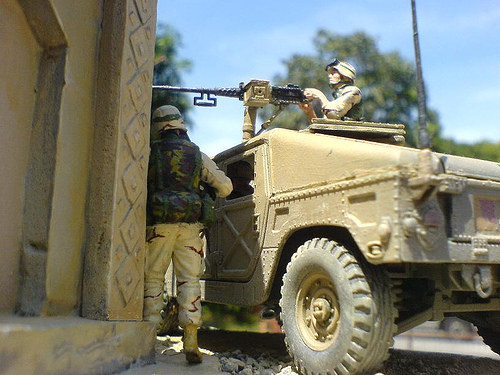Diorama/Vignettes
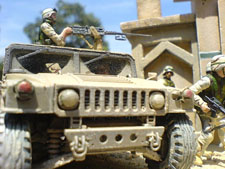 |
The root word diorama means to tell as story in the round. It can also be defined as a scene that captures a moment in time. We often think of dioramas as being small in scale but they don't necessarily have to be small scale. Dioramas can also be life size as in many museum dioramas. The definition of a diorama can be pretty broad and covers a lot of areas but that is the nature of a diorama. |
In this diorama page, I will be touching on dioramas for 1:35 scale military miniatures-the scale that I have worked on before and enjoy most. It can be almost anything as long as it captures a moment in time and displays some type of scene with multiple objects. A diorama needs to have realism and intimacy so that it will involve the viewer in the storytelling process.
A vignette is a display which do not necessarily tell a story and is much smaller in size than a diorama. In the Tamiya rulebook, any scene lesser than 3 figures is not a diorama. So vignetes typically displays between 1-2 miniature figures only.
There are many different types of dioramas but if you break it down there are two main categories- military and non military.
Planning and basic composition
Before you get started on a diorama project, have a clear idea of what sort of diorama that you want to work on. Do your research by reading magazines or the internet and get the references you need. You can easily find what the landscape of a battle was or the kinds of weapons being used if you're willing to put some time into finding them out.
In this instance, I chose to build a scene during a 2003 operation in Fallujah, Iraq . I used modern 1/35 plastic US infantry
of various brands as my figures and chose a 1/35 Humvee
. The mosque was scratched build out of a foam board, cylindrical polystyrene and the dome was made from a rounded polystyrene.
Sketch and PlanningSketch out the scene on a piece of paper- simple stick figures will help you visualize the scene and figure out all the materials or items to get. You will also be able to foresee the layout and composition of the diorama before you proceed to the building stage. Some diorama builders draw a plan of the scene instead to see layout of the diorama. Any major changes should be done during this stage. Basic CompositionLike painting a picture, a little knowledge of composition will go a long way. Although there are no set ways of doing things, however there are some basic rules in composition that I like to share. Though the topic of composition can be a wide topic, here I will try to highlight some things that I believe are the most basic.
Once that is established, the flow will lead them in a clockwise or anti- clockwise to the next object and so on. For example, a tall building flows onto a lamppost than onto a tank than onto a soldier-in other words usually from the biggest object or tallest to the lowest or smallest. All these objects are carefully arranged or composed in a circular pattern next to one another in a smooth rhythm which guides and pleases the eyes of the viewer. Examples of basic flow shapes are like an ‘O, a reverse C, U etc.... This patterns need to be present in order for concept of flow to work. |
|
|
DirectionAnother key point in composition is direction. A diorama tells a story and where the main action is taking place is the direction. Placing the front of the vehicle to the left shows the direction of the story is on the left. In the photo to the left and above shows the gunner of the mounted aiming the M2 Browning at the door of the building. |
The heads of US infantry figures are primarily facing or looking to the direction of where the action is taking place. That will lock down the direction of the diorama-where the action is which is the doorway of the building.
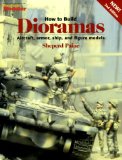 |
Building Diorama EssentialsIf you are serious about building dioramas and want to get ahead of others, I would like to recommend 3 top notch books that will help you achieve that. The first book that I recommend is How to Build dioramas How to Build Dioramas is an essential book on creating dioramas from basic to advanced levels. |
The topics covered are about utilising paint schemes, weathering, figure posing and super detailing of minature buildings. There are plentiful of realistic looking photos of the author's dioramas that will inspire and awe you.
The explainations are simple to understand and are well arranged in stages for you to follow. This book is highly recommended by many modellers and comes in paperpack.
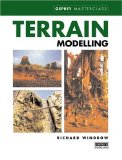 |
The second book that is worth mentioning countless times is Terrain Modelling With plenty of step by step photos as guide, I can simply say that this is the bible of building realistic looking terrains. I have searched everywhere and found that this book only comes in hardcover edition. It is pricer than most modelling books but if you are a true diorama builder, you should save up and add this book into your collection. |
Yet another book by Richard Windrow is called Advanced Terrain Modelling. If you are in need of more creative ideas about terrain modelling, consider this book. In this book, the author cover both military and non military terrains-that is probably why some hardcore military modellers are unhappy about.
If you are hungry for more adventurous terrain layouts and miniature landscapes get this book.
How to Build a Fantasy Diorama next pageBonus Tips
Below are some more articles I wrote on other websites. Please check them out to get more tips on making dioramas:
How to Add Grass and Texture to The Base of Your MiniatureUse Water Based Stains And Varnishes For Your MIniature
Planning A Miniature Diorama of Isengard
Painting Realistic Stones
Making A Miniature 3D Relief Structure
Sketch To Screen: Making A Miniature Structure
Creative DIY Bases for Miniatures
Craft Projects That Can Save The Earth
Secrets to Making a Miniature Tree
http://gomestic.com/do-it-yourself/use-water-based-stains-and-varnishes-for-your-wooden-base/





